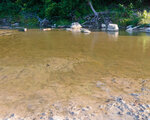

The sudden turn-up of the Texas heat has many people looking toward Lake Granbury and up the Brazos River for relief from the heat, but where you swim can be deadly and not for the most common reasons that spring to mind.
Primary amoebic meningoencephalitis or PAM is a rare brain infection caused when swimmers encounter Naegleria fowleri, an amoeba found in fresh water and soil.
While PAM is rare, with an average of fewer than three cases a year, Texas deaths have made up about a third of the fatalities in the past decade. The most recent occurred last September when three-year-old Bakari Williams contracted the infection at an Arlington splash pad. In 2019, the infection claimed the life of Valley Mills’ 10-year-old Lily Avant, who caught the infection over the Labor Day weekend while playing in the Brazos River.
The CDC reports that those infected die one to 18 days after symptoms begin, the median being five days.
PAM is caused by Naegleria fowleri, an amoeba commonly found in warm fresh water (lakes, rivers, creeks) or soil. The amoeba infects people when it enters through the nose and travels to the brain, where it causes the PAM infection. The trigger point for the amoeba is believed to be 80 degree and warmer fresh water.
In recent years, there have been promising developments in treating the infection. Still, the main problem remaining is recognizing its presence and sorting that out from typical symptoms of too much party fun or a common illness like the flu.
Generally, the person infected first has several frontal headaches, fever, nausea and vomiting. The secondary stage includes a stiff neck, altered memory, seizures, hallucinations and coma.
PAM is difficult to detect because it progresses rapidly, and the symptoms are similar to the flu, bacterial meningitis or other more common illnesses. Sadly, the diagnosis of having PAM is generally made after death. In living patients, it can only be diagnosed by spinal tap.
Oddly enough, you cannot become infected from swallowing water contaminated with Naegleria.
Here are some tips from the Texas Department of Health Services on keeping yourself safe from PAM.
According to the TDSHS, most PAM infections occur at low water levels and during high temperatures. With 2022 expected to be hotter than average and with a lack of rainfall, PAM infections may start earlier in the year.
Infections are believed to occur the easiest when water is forced up the nose and into the nasal cavity. To avoid this from happening, a swimmer should use a nose clip or pinch their nose closed while jumping into the water. It’s best to avoid stirring up underwater sediment because the amoeba is often found in soil.
Avoid stagnant water and bodies of warm fresh water with low levels, and avoid all waters posted with “no swimming” signs. Properly cleaned hot tubs and swimming pools are generally considered to be safe. Still, the Arlington splash pad incident reminds us of what can happen if properly cleaning, chlorinating and maintenance are not done.
If you begin experiencing symptoms after a water outing where water has gotten up your nose, you should monitor yourself for flu-like signs.
If you begin showing signs, going to a medical professional and informing them that you may have been exposed to the amoeba could save your life.
Time is of the essence because specific tests must be conducted to identify the PAM disease before treatment may begin. Telling medical professionals about potential exposure is critical.
We can all stay safe this summer on Lake Granbury and the Brazos River by being aware and educating others.
For more information about PAM, call the Texas Department of State Health Services at 512-776-7111. For toll-free, please dial 1-888-963-7111.
Russell@hcnews.com | 817-573-7066 ext. 231